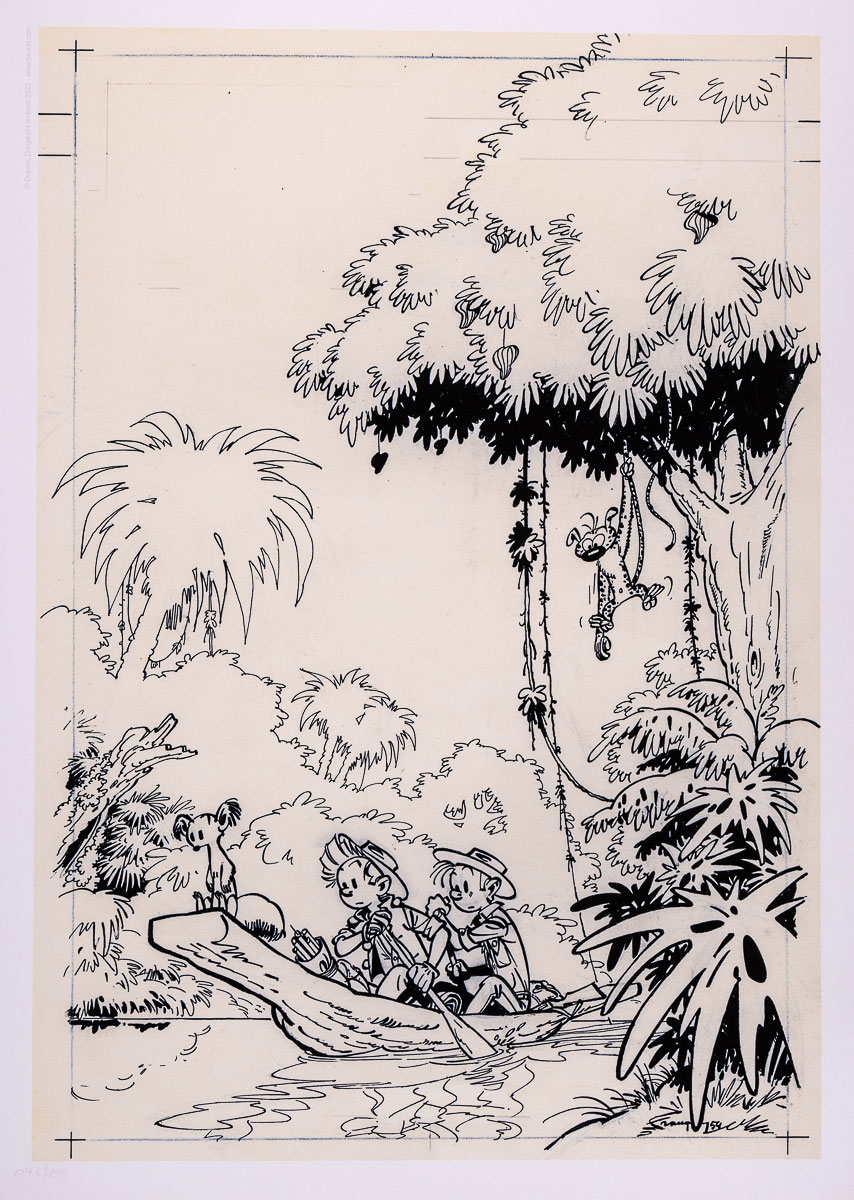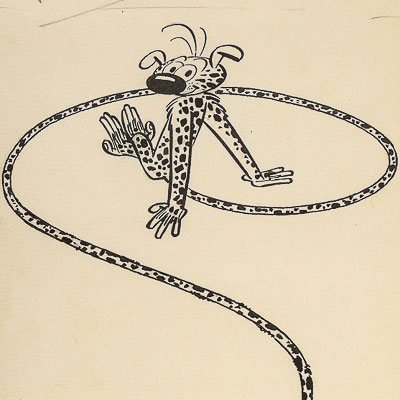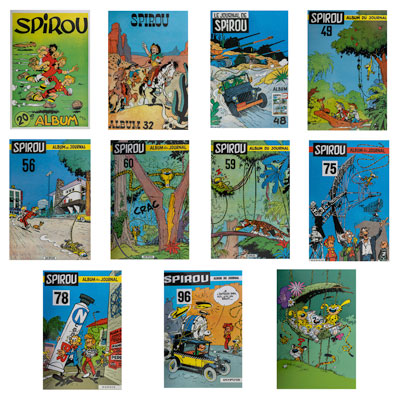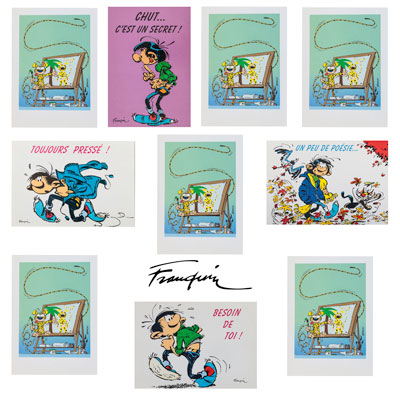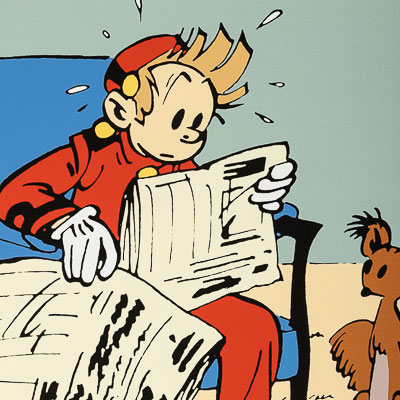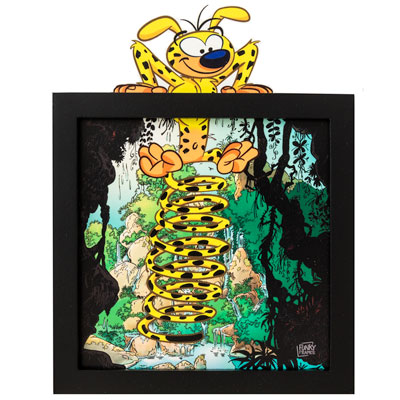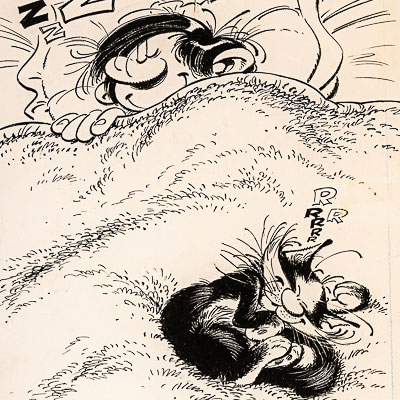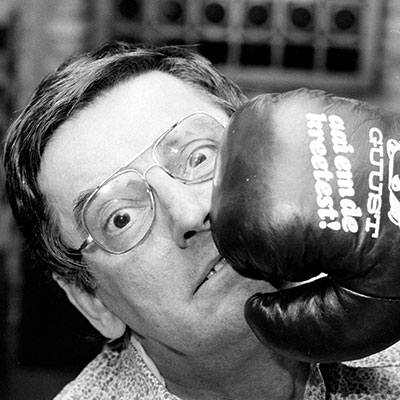Tel : (+33) 4 94 63 18 08
9am - 6pm from Monday to Saturday
All products André FRANQUIN • Products of the serie Marsupilami
Franquin Fine Art Pigment Print : Spirou, Fantasio, and the Marsupilami - The canoe
REF : FRANQ-PIG-03
In stock
Only 1 in stock
Unavailable
149,00 €
Luxurious pigment print numbered edition of André Franquin's work: Spirou, Fantasio, and the Marsupilami - The canoe
Limited edition of 199 copies, delivered with numbered certificate.
This pigment print reproduces the 1954 paper drawing (with India ink, blue pencil, and lead) that served as the basis for the cover of Recueil Spirou No. 49, published on April 1, 1954 by Dupuis Editions.
Medium: Ifa 22 paper, 315 g/m²
Dimensions: 43 x 60 cm.
Marsupilami
The Marsupilami is a comic strip series created in 1952 by André Franquin and published in the Belgian youth newspaper "Spirou". In 1987, the Marsupilami had its own series, with a script by Yann and drawings by Nicolas Loup. Since then, many writers and illustrators have participated in the creation of the series, such as Batem and Jidéhem. It is published by Marsu Productions. It features an imaginary animal with the behavior of a marsupial like the kangaroo and the habit of making nests in trees like gorillas. The Marsupilami is also amphibious like marine mammals and has a coat similar to that of a feline. Finally, it has exceptional intelligence compared to that of great apes. The Marsupilami lives in the jungle of Palombia, South America, and is very endearing and very popular with readers. The series follows the adventures of this colorful character and his friends, Spirou and Fantasio, as they explore the jungle and encounter many colorful characters. Find the Marsupilami, this adorable and mischievous creature imagined and drawn by Franquin and then entrusted to Batem in our vast selection of art posters, pigment prints, screen prints, postcards and Funky Frames. Carefully chosen and selected articles for you from our publishers.
Discover the artist
FRANQUIN André
André FRANQUIN is a Belgian cartoonist, the main representative of the School of Charleroi, known as the Dark Line, in opposition to the Clear Line, whose main representative is Hergé.
After entering an art school, despite his father’s disapproval, he followed up with a small Belgian cartoon studio in the middle of World War II. It is there that he will meet Morris (future creator of Lucky Luke) and Peyo (future author of Smurfs). The adventure is short-lived, but Morris then takes him to Dupuis for the periodical Spirou. Here begins the real adventure!
It was Jigé who reigned over Spirou, drawing almost all the boards alone. But Jigé wants to keep time to focus on other projects and these young people engaged in the late 1940s, will be the "heirs"! Staying in the house of Jigé, first in Belgium, then following him in the United States and Mexico, the young comic books cretators will, based on Jigé’s experience, become the pillars of the Belgian comic book of the post-war period.
In June 1946, Franquin took over (in progress) an album by Jigé Spirou and the prefabricated house that had drawn the first 8 pages. He manages to make the transition invisible, slipping perfectly in the footsteps of Jigé. From then on, he became THE draughtsman of Spirou (originally created by Rob-Vel) and in 1952, he introduced in the album Spirou et les Héritiers a new character : the Marsupilami !
Like Jigé, before him, Franquin will have to surround himself with a team of young designers to ensure the speed of publication of the series on which he officiates; Greg, Jidéhem or Roba will be among those.
Once released from part of his work, in 1957, Franquin introduced a new character in the periodical Spirou: unemployed, blundering at all times, Gaston enters the scene! Franquin’s inventiveness appears here again, of an impressive modernity! Gaston benefits from the precise feature, the ability of the comic book artist to put the movement into a picture and, in a fully comic and burlesque tone, to surf on the time! (Remember that the comic book was primarily intended for children and adolescents, at that time)
The 60s will be marked by the too full! Franquin enters into a depression, feeling as if he is running in circles on Spirou and Fantasio (which he did not create, whose rights are the property of Dupuis), no longer feel like drawing these adventures that they feel like they yearn for his strength and do not represent what he loves and means. (It should be noted that the album that will make him fall in love: QRN on Bretzelburg, written by Greg, is considered by fans as one of the best albums of Spirou!). Jean-Claude Fournier will take over the series and Franquin will fully devote himself to Gaston !
In addition to Gaston (where the gags in one page become the rule and where gags in the background reinforce the comic side), Franquin becomes a screenwriter for other cartoonists (notably Will and Janin), then embarks on the adventure of the Trombone illustré (supplement at the heart of Spirou where Franquin has complete freedom during 30 issues). It is in this little periodical that Idées noires will be born. Breaking with the rest of his work, Franquin (in black and white) sketches a society in full decline where he attacks everything he does not like (military, religion, consumerism, etc). Besides, these years are political, Franquin drawing for Greenpeace, Amnesty or UNICEF and even making Gaston a character committed to ecology. It was Fluide Glacial (after the end of the Trombone illustré) who took over the publication of Idées noires, Gotlib being a friend and an admirer of Franquin.
Although he had given up on the Spirou and Fantasio adventure, Franquin still owned the Marsupilami he had created. But until 1987 (after two more years of depression that mades him stop everything), he did not stage it anymore! Under the impulse of a fan and with the help of Greg and a young cartoonist (Batem), he relaunches this iconic hero, with an immense success. He then invested himself in the animated series Les Tifous (to the point of abandoning Gaston!) for which he worked tirelessly, giving birth to 78 episodes.
He returned to Gaston for the release of Album n°15 in 1996. It met with tremendous success (650,000 copies sold in less than six weeks) and remained the last of the Gastons, since André Franquin died of a heart attack at the beginning of 1997, leaving orphans all these characters that punctuated our childhoods !
